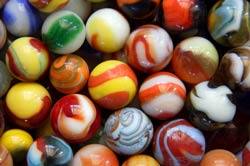Packin’ ‘em In
If you carefully stack equal-sized marbles in a box, they will fill about 74% of its volume. But if you dump them in, they won’t fill up more than about 64%, no matter how much you jiggle the box. Researchers have measured this “random close packing” limit but can’t explain it. Now a Russian team reports in the 8 June Physical Review Letters that the limit occurs when virtually all marbles form into distorted pyramid shapes called quasiregular tetrahedra. The research clarifies how simple components–or the molecules in non-crystalline solids–can get stuck in arrangements that are locally convenient but less than ideal for the whole group.
Making a dense, ordered arrangement of spheres is child’s play: stack successive triangularly packed layers so that the spheres in each layer align with holes in the one below. In 1611 Johannes Kepler conjectured that the 74% filling in this crystalline packing is as dense as you can get. In 1998 Thomas Hales, then at the University of Michigan, finally proved Kepler right, using a computer to help analyze more than 5,000 types of configurations.
In the 1950s, J. D. Bernal of the University of London analyzed the random case by dissecting actual clusters of ball bearings. He found that they filled about 64% of the total volume, much less than in the crystal. Since then, researchers have observed this “Bernal limit” in labs and on computers, but they still can’t explain its value. Nor is there a precise definition of the random close packed state itself. Now Alexey Anikeenko and Nikolai Medvedev, of the Institute of Chemical Kinetics and Combustion in Novosibirsk, Russia, have devised a new way to describe this special state. Although researchers have measured various parameters, such as the distances between spheres, Medvedev says that “to understand the nature of packings one must study the three-dimensional elementary units.”
The researchers simulated on a computer hundreds of different arrangements of spheres, with a range of densities. Some configurations included crystalline regions, so they were denser than the Bernal limit. The team then looked within each jumble for four-sphere clusters that formed approximate tetrahedra–distorted triangular pyramids.
To classify these structures, they adopted a scheme from Hales’s proof of the Kepler conjecture. Any group of four spheres is called a tetrahedron if the longest edge connecting them is no more than 25% longer than its value for a perfect tetrahedron. It is critical to include spheres that aren’t touching, Medvedev says, because disordered packings do not contain perfect tetrahedra.
The pair then searched their simulations for larger, “polytetrahedral” clusters that included only neighboring tetrahedra that shared triangular faces. As they increased the density of spheres, they found that such clusters made up an ever-growing fraction of the volume. As the density rose toward the Bernal limit, virtually all of the spheres became part of tetrahedral units. Above the Bernal limit, the volume of polytetrahedral clusters decreased as crystalline regions took over.
Medvedev says that this analysis is a good starting point for describing the random, close-packed state mathematically, and may help explain why disordered solids called glasses freeze in a liquid-like state instead of forming a crystal. Andrea Liu of the University of Pennsylvania agrees that the new results are intriguing but says that researchers need to learn how the tetrahedral description “connects with stuff we already know,” including recent hints of a true phase transition as the density passes through the Bernal limit.
–Don Monroe
Don Monroe is a freelance science writer in Murray Hill, New Jersey.
More Information
March 2007 comments on related research by Liu and R. D. Kamien
Thomas Hale’s description of his 1998 proof of the Kepler conjecture on the densest crystalline packing of spheres
a sphere-shaking technique to move from random packing to some crystallization: O. Pouliquen, M. Nicolas, and P. D. Weidman, “Crystallization of non-Brownian Spheres under Horizontal Shaking,” Phys. Rev. Lett. 79, 3640 (1997)





